Abstract
CVD growth conditions, particularly growth temperature and partial pressures of the reactant gases, strongly affect the growth characteristics and properties of GaAs0.6P0.4 epitaxial layers grown on GaAs substrates. For LED’s the most important properties of the material are B/J (brightness per unit current density) and surface morphology. This paper presents the results of a systematic study of the effect of temperature and reactant gas partial pressure (at a fixed III/V ratio) on B/J, surface morphology, growth rate, impurity doping and layer composition. Growth conditions which yield the optimum properties for LED’s are determined. The results are interpreted on the basis of kinetic and thermodynamic mechanisms controlling the growth process under various growth conditions. At constant temperature and constant III/V ratio, increasing the partial pressures causes the growth process to change from mass transport limited, where the growth rate increases with increasing partial pressures, to kinetically limited, where the growth rate is independent of partial pressures. Good morphology layers are obtained over a range of partial pressures around the transition from mass transport limited to kinetically limited growth. The B/J peaks at a value of partial pressure in the kinetically limited regime at which good morphology layers are obtained. Although B/J increases with increasing growth rate in the mass transport regime, the maximum B/J occurs in the region where growth rate is independent of partial pressures so that growth rate alone is not sufficient to determine B/J. In contrast to the “parabolic≓ dependence of growth rate on growth temperature, caused by the transition from the mass transport regime to the kinetic regime, the relative incorporation of As, P, and Te varies with temperature in the manner predicted from thermodynamics in both regimes. This behavior is consistent with the growth rate in the kinetic regime being limited by the desorption of chlorine atoms from the growth surface, with the reaction of As, P, and Te with the Ga proceeding thermodynamically at all temperatures.
Similar content being viewed by others
References
W. F. Finch and E. W. Mehal, J. Electrochem. Soc.,111, 814 (1964).
J. J. Tietjen and J. A. Amick, J. Electrochem Soc,113, 724 (1966).
C. J. Nuese, J. J. Tietjen, J. J. Gannon and H. F. Gossenberger, J. Electrochem. Soc,116, 248 (1969).
M. Ogirima and K. Kurata, Japanese J. Appl. Phys.,10, 1474 (1971).
Chr. Belouet, J. Crystal Growth,13/14, 342 (1972).
D. Shaw , in “Crystal Growth — Theory and Techniques”, Volume1, Chapter 1, edited by C. H. L. Goodman, Plenum Press (1974); also D. Shaw, J. Crystal Growth, 31, 130 (1975).
D. Shaw, J. Electrochem. Soc,115, 405 (1968).
D. Shaw, J. Electrochem. Soc,117, 683 (1970).
V. S. Ban, J. Electrochem. Soc,118, 1473 (1971).
D. J. Kirwan, J. Electrochem. Soc,117, 1572 (1970).
N. Johnson, J. Electrochem. Soc,110, 117 (1963).
R. D. Fergusson and T. Garbor, J. Electrochem. Soc, 111, 585 (1964).
D. Wagman, et al., “Selected Values of Chemical Thermo-dynamic Properties”, National Bureau of Standards Technical Note 270-3, 219 (1965).
H. Seki, K. Moriyama, I. Asakawa and S. Horie, Japanese J. Appl. Phys.,7, 1324 (1968).
A. Boucher and L. Hollan, J. Electrochem. Soc,117, 932 (1970).
T. Manabe, T. Gejyo and H. Seki, Japanese J. Appl. Phys.,10, 1466 (1971).
M. Bleicher, J. Electrochem. Soc,119, 613 (1972).
H. Watanabe, T. Nighinaga and T. Arizumi, J. Crystal Growth,17, 183 (1972).
T. Y. Wu, J. Electrochem. Soc, 121., 1357 (1974).
K. E. Enstrom, C. J. Nuese, J. R. Appert, and J. J. Gannon, J. Electrochem. Soc,121. 1516 (1974).
B. W. Wessels, J. Electrochem. Soc,122, 402 (1975).
G. B. Stringfellow and H. T. Hall, Jr., J. Electrochem. Soc, 123, 916 (1976).
J. W. Philbrick and W. C. Westenhoefer, J. Electronic Materials,3, 475 (1974).
V. S. Ban, H. F. Gossenberger and J. J. Tietjen, J. Appl. Phys.,43, 2471 (1972).
J. V. DiLorenzo, J. Crystal Growth,17, 187 (1972).
J. K. Kennedy and W. D. Potter, J. Crystal Growth,19, 85 (1973).
J. J. Tietjan, M. S. Abrahams, A. B. Dreeben and H. F. Gossenberger, in Pro. Second Intern. Symp. on Gallium Arsenide (Inst. Phys. Soc. Conf., 1969, Ser. No. 7) p. 55.
V. K. Subashiev and G. A. Chalikyan, Sov. Phys. Semiconductors,3, 216 (1970).
M. G. Millvidskii, V. B. Osvenskii, V. I. Fistuall, E. M. Omel'yanovskii and S. P. Grishina, Sov. Phys. Semiconductors,1, 813 (1968).
R. C. Taylor, J. Electrochem. Soc,118, 364 (1971).
According to Sidorov, et al., (reference 32), when the doping process occurs under equilibrium conditions, the doping should reflect extrinsic behavior and the donor concentration should be proportional to the square root of the vapor phase concentration. However, a linear dependance has been found by us for Ga(As,P), by Stewart (reference 33) and by van der Does de Bye and Peters (reverence 34) for GaP. The linear dependance indicates that the doping occurs under non-equilibrium conditions.
Yu G. Sidorov, L. F. Vasileva, I. V. Sabinina, S. A. Dvoretsky and A. V. Sidorova, J. Electrochem. Soc.,123, 698 (1976).
C. E. E. Stewart, J. Crystal Growth,8, 259 (1971).
J. A. W. van der Does de Bye and R. C. Peters, Philips Res. Rept.24, 210 (1969).
A. H. Herzog, W. O. Groves and M. B. Craford, J. Appl. Phys.,40, 1839 (1969).
O. Listiko, Jr. and C. A. Bittmann, Solid State Electronics,16, 1321 (1973).
C. Wu, unpublished results.
Thermodynamic calculation was done by C. Wu using equations derived by Kirwan (reference 10). The results indicate that the composition change is about 1% over the partial pressure range shown in Figure 9.
W. L. Snyder and C. Wu, unpublished results.
R. Cadoret and M. Cadoret, J. Crystal Growth,31, 142 (1975).
Author information
Authors and Affiliations
Rights and permissions
About this article
Cite this article
Wu, C.H., Solomon, R., Snyder, W.L. et al. Optimization studies of CVD growth of GaAs0.6P0.4 . J. Electron. Mater. 7, 791–821 (1978). https://doi.org/10.1007/BF02655475
Received:
Revised:
Issue Date:
DOI: https://doi.org/10.1007/BF02655475




